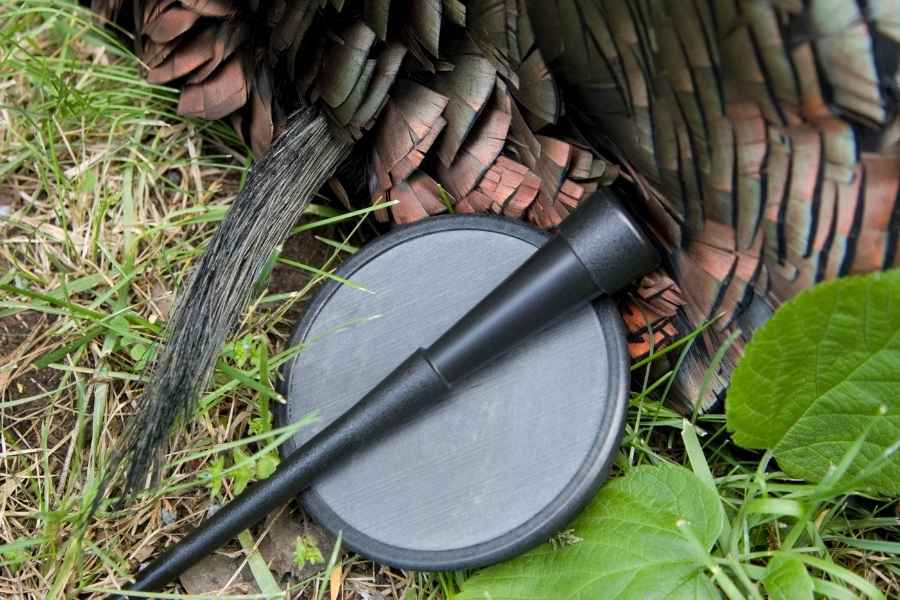Turkey calls often play second fiddle to more flashy hunting gear like bows and rifles, but they hold their own with unmatched subtlety and finesse in the art of turkey hunting. This unique tool in your hunting arsenal sets you apart in the vast wilderness, offering a distinct approach that marks the seasoned turkey hunter from the novice. The primary types of turkey calls—Box, Slate, Diaphragm, and Push-Pull Calls—each bring their own flavor to the hunt.
Single Reed Diaphragm calls, in particular, offer a hands-free, but complex option for those looking to master the call of the wild turkey. Diving deeper, each turkey call type presents its own set of sounds, handling techniques, historical roots, and scenarios where they shine the brightest. The following sections will delve into these facets in more detail, providing a comprehensive understanding of what makes each turkey call an essential piece of your hunting toolkit.
Whether you’re looking to mimic the seductive yelp of a hen or the commanding gobble of a tom, understanding the nuances of your turkey calls can elevate your hunting experience to new heights.
The Call
A turkey call is your tool for speaking the language of the wild turkey. It’s a collection of tools—ranging from box calls to diaphragm calls—each designed to mimic the various sounds turkeys make. The setup is not just about having the right calls, though.
It’s also about knowing how to use them to communicate effectively with turkeys, whether you’re trying to lure in a cautious tom or blend into the natural sounds of the woods. Getting your setup right means choosing the right call for your environment and skill level, then mastering the techniques to make those authentic turkey sounds. It’s a blend of art and science, requiring patience, practice, and a keen understanding of turkey behavior.
Example Scenarios:
- Open Fields: In the vast openness of fields where sound travels far, a box call with its loud, resonant sound can be particularly effective. Its ability to project clear turkey calls over long distances makes it ideal for such environments. For example, a hunter might use a box call to emit a series of yelps and cutts to simulate a hen looking for a mate, which can be heard by toms from afar.
- Dense Woods: The dense woods require a more subtle approach due to the proximity of turkeys and the ease with which sound can be muffled by foliage. Here, a diaphragm call shines due to its hands-free operation and the ability to produce a variety of sounds without movement that might spook nearby turkeys. A hunter moving through thick brush might use soft purrs and clucks to mimic a feeding hen, keeping their hands free for their weapon as they call.
- Riverside Setups: Near water sources, where turkeys often roam for drinking and feeding, the versatility of a slate call can be advantageous. The nuanced, softer calls that can be produced with a slate call are perfect for such scenarios. A hunter might use gentle purring sounds to attract a turkey across the water, offering the illusion of a hen quietly feeding along the bank.
- Windy Conditions: On windy days when softer calls might be carried away or distorted by the wind, the push-pull call, with its consistent and clear sound, can be particularly useful. Its ease of use and ability to cut through the noise of the wind make it a go-to choice. A hunter might use a series of loud yelps to catch the attention of a tom that’s further away, ensuring the call is heard despite the challenging conditions.
Each scenario underscores the importance of matching your turkey call setup to the specific conditions of your hunting environment. By understanding the strengths and applications of each type of call, hunters can enhance their ability to communicate effectively with turkeys, increasing their chances of a successful hunt.
Why is a proper turkey call setup important?
Having the right turkey call setup is crucial because it directly impacts your ability to mimic natural turkey sounds, which is essential for attracting turkeys during a hunt. A proper setup not only increases your chances of a successful hunt by drawing turkeys closer but also enhances the overall hunting experience by making you a part of the natural environment. It’s about more than just making noise; it’s about communicating in a language that turkeys understand.
Whether you’re a seasoned hunter or a beginner, mastering this aspect of hunting can make all the difference in your success and enjoyment in the field.
Mimics natural turkey sounds to attract them
A well-crafted turkey call setup is your key to unlocking the language of the turkeys. By accurately mimicking the calls—whether it’s the gentle purr of a content hen or the sharp cutts of one that’s alert—you bridge the gap between hunter and prey. This mimicry is what draws the turkeys closer, thinking they’re approaching one of their own.
- Box Calls: Ideal for loud, clear yelps and cutts that can travel across open fields, making them perfect for windy days or when trying to cover more ground audibly.
- Slate Calls: Best for soft purrs and clucks, simulating the feeding or contentment sounds of a hen, which can be incredibly effective in calm, close-range scenarios.
- Diaphragm Calls: Allows for a variety of sounds including kee-kees, yelps, and gobbles, with the hands-free advantage for use when turkeys are in sight and stealth is paramount.
- Push-Pull Calls: Simple to use, producing consistent clucks and purrs with minimal movement, ideal for beginners or in situations where ease of use is key.
Increases chances of a successful hunt
With every precise call that emulates the natural sounds of turkeys, your chances of a successful hunt improve significantly. It’s not just about attracting any turkey; it’s about attracting the right turkey, at the right time, in the right way. This strategic communication can mean the difference between a day filled with missed opportunities and one that ends with a successful harvest.
- Anecdotal Evidence: Many seasoned hunters recount tales where a well-timed purr or a series of yelps turned a day of fruitless waiting into a successful harvest, underscoring the power of effective communication.
- Statistical Data: Surveys among turkey hunters indicate that those who utilize a variety of calls tailored to their environment and the turkey’s behavior tend to report higher success rates compared to those who rely on a single call type or minimal calling.
In the world of bowhunting, where every advantage counts, a proper turkey call setup is an invaluable tool in your arsenal. Understanding and implementing the nuances of turkey calling can significantly elevate your hunting experience, bringing you closer to the elusive goal of a successful turkey hunt.
What are the types of turkey calls?
In the world of turkey hunting, diversity in your call setup can be a game-changer. The main types of turkey calls each offer unique advantages and challenges. Box calls stand out for their versatility and ease of use, making them a favorite among beginners.
Slate calls, with their need for a striker, allow for the creation of subtle, nuanced sounds that can be crucial in wary turkey scenarios. Diaphragm calls offer the advantage of being hands-free, allowing for more natural movement, though they do require a bit more skill to master. Lastly, push-pull calls are known for their simplicity and user-friendliness, perfect for those looking for reliability without the complexity.
Each type of call plays a specific role in your hunting strategy, and understanding their differences is key to choosing the right one for your next hunt.
| Call Type | Brand/Model Recommendations |
|---|---|
| Box Calls Box calls are versatile and very easy to use. Perfect for a beginner, quick to master, but require two hands. We like the Lynch World Champ the most of the two. | |
| Slate Calls Achieve very loud or very quiet sounds, very versatile but requires finesse and some skill. | |
| Diaphragm Calls Hands free, with tons of calls possible, but has the highest learning curve. Prepare to practice – a lot! | |
| Push-Pull Calls The easiest by far, just push or pull the rod and a pur, yelp, or cut comes out depending. One handed action makes these great for beginners. | |
Box calls: versatile, good for beginners
Box calls are the go-to for many hunters, especially those just starting out. Their design is simple yet effective, allowing for a wide range of turkey sounds with minimal practice. The versatility of box calls means they can be used in a variety of hunting scenarios, making them a solid choice for beginners looking to get a feel for calling.
Slate calls: requires a striker, subtle sounds
Slate calls demand a bit more finesse, utilizing a striker to produce sounds. The beauty of slate calls lies in their ability to create incredibly subtle and nuanced sounds, perfect for those moments when a soft touch is needed to lure in a wary turkey. Mastery of the slate call opens up a world of sound possibilities.
Diaphragm calls: hands-free, challenging to master
For those looking for a hands-free option, diaphragm calls are the answer. Positioned in the mouth, these calls allow hunters to keep their hands on their bow or gun. However, they come with a steep learning curve.
Mastering the diaphragm call requires control over breath and tongue placement, but once achieved, it offers unparalleled sound variety without sacrificing readiness.
Push-pull calls: simple, user-friendly
Push-pull calls are as straightforward as they sound. Their simple mechanism makes them extremely user-friendly, ideal for those who prefer a no-fuss approach to calling. While they may not offer the same range as other calls, their reliability and ease of use make them a favorite for quick and effective communication in the field.
This detailed table provides a comprehensive overview of the main types of turkey calls, including specific brand and model recommendations, their advantages, and ideal scenarios for use. This information aims to assist hunters in choosing the right turkey call to enhance their hunting experience.
How to choose the right turkey call?
Choosing the right turkey call involves a careful consideration of your hunting environment and your personal skill level. Each type of call—whether it’s a box, slate, diaphragm, or push-pull—serves a specific purpose and excels in different scenarios. For instance, if you’re hunting in an area where stealth is key, a hands-free diaphragm call might be your best bet.
On the other hand, beginners might find the straightforward design of box calls more manageable. It’s also important to assess how comfortable you are with each type of call. While diaphragm calls offer great versatility, they require practice to master.
Ultimately, the right turkey call is one that not only suits the environment you’re hunting in but also matches your level of experience and comfort with the instrument.
Consider the specific hunting environment
When selecting a turkey call, the environment you plan to hunt in plays a pivotal role. Dense woods or open fields each have their own acoustic characteristics, which can influence how sound travels. For instance, in thick forests, a box call’s clear, resonant tones can cut through the underbrush, while the subtle sounds of a slate call may be ideal for open areas where sound carries farther.
| Environment | Recommended Call Type | Reason |
|---|---|---|
| Dense Forests | Diaphragm Call | Allows for stealthy, hands-free calling amidst dense foliage. |
| Open Fields | Box Call | Loud, far-reaching calls suitable for open spaces. |
| Quiet Mornings | Slate Call | Subtle, soft calls that won’t startle turkeys in calm conditions. |
| Windy Conditions | Push-Pull Call | Simple, effective calls that can cut through wind noise. |
Assess personal skill level and experience
Your proficiency and comfort with different types of turkey calls should also steer your choice. If you’re new to turkey hunting, starting with a more user-friendly option like a box call or a push-pull call might be wise, as these require less technique to produce effective calls. For seasoned hunters looking for a challenge or wanting more control over the sounds they produce, diaphragm calls or slate calls offer complexity and a wider range of vocalizations.
| Skill Level | Recommended Call Type | Recommended Models | Reason |
|---|---|---|---|
| Beginner | Box Call | Lynch World Champion | Easy to use with minimal practice required. |
| Intermediate | Slate Call | WoodHaven Cherry Classic | Offers nuanced control for those with some experience. |
| Advanced | Diaphragm Call | WoodHaven 3 Pack | Provides a wide range of sounds for skilled users. |
| All Levels | Push-Pull Call | Quaker Boy Cyclone Box Call | Simple and effective, suitable for hunters of any skill level. |
How to set up a box call?
Setting up a box call for turkey hunting involves a few key steps to ensure it performs at its best. First, you’ll want to chalk the surface of the box call. This is crucial for creating the friction needed to produce clear, natural-sounding turkey calls.
Regular, non-oil-based chalk is recommended to avoid dampening the sound. Next, practicing different holding techniques can significantly affect the variety of sounds you’re able to produce. From soft purrs to loud yelps, the way you grip and move the box call can mimic the diverse vocalizations of turkeys.
Getting comfortable with these techniques before heading out into the field can make all the difference in attracting turkeys during your hunt.
Chalk the surface for smooth operation
Chalking the surface of your box call is a critical first step in your setup. This simple act ensures the wood surfaces can glide smoothly against each other, producing a range of turkey sounds that can go from a soft cluck to a loud yelp. Use a non-oil-based chalk to maintain the wood’s natural ability to create friction, which is essential for the call’s effectiveness.
- Step-by-Step Guide to Chalking:
- Select the Right Chalk: Use a non-oil-based chalk. Avoid using school chalk or sidewalk chalk, as these may not provide the right texture.
- Apply Chalk: Hold the chalk flat against the surface of the box call and rub it back and forth along the entire length of the striking surfaces. Ensure an even coat.
- Test the Sound: After chalking, gently glide the lid of the box call across the chalked surface to test the sound. If it’s not producing the desired clear, sharp sound, apply more chalk.
- Reapply as Needed: Chalk wears off with use, so reapply before each hunting trip or even during the hunt as needed. A good rule of thumb is to check the sound quality before starting your calling sequence and rechalk if the call sounds dull.
Practice holding techniques for different sounds
Mastering various holding techniques for your box call can vastly expand the repertoire of sounds you’re able to produce. Each grip and motion can mimic a different turkey vocalization, from the gentle purring of a content hen to the sharp cutts of an alert one. Spend time experimenting with the pressure and speed of your strokes, as well as the angle at which you hold the call.
- Tips for Holding Techniques:
- Grip Firmly but Gently: Hold the base of the box call in one hand and use the other hand to move the lid. Your grip should be firm enough to control the call but gentle enough to allow for nuanced movements.
- Vary Your Strokes: For yelps, slide the lid in a smooth, consistent motion. For clucks, tap the lid lightly and quickly. For purring, drag the lid slowly with slight pressure.
- Adjust the Angle: Tilting the box call slightly can change the pitch and tone of the call. Experiment with different angles to find the sounds that work best for your hunting scenario.
- Practice Makes Perfect: Spend time practicing your calls before the hunt. Try to mimic the natural sequences of turkey sounds, combining yelps, clucks, and purrs to create a realistic turkey conversation.
How to set up a slate call?
Setting up a slate call for turkey hunting is a nuanced process that focuses on precision and subtlety. The first step involves conditioning the surface of the slate to ensure it can produce clear, consistent sounds. This can be achieved by lightly sanding the surface to create the right texture for the striker to interact with.
The next key aspect is mastering the use of the striker, which is used to create the turkey sounds. By varying the pressure, speed, and angle of the striker against the slate, you can produce a wide range of turkey calls, from soft purrs to sharp yelps. Familiarizing yourself with these techniques and understanding the subtle adjustments needed for different sounds is crucial for effectively using a slate call in the field.
Condition the surface for clear, consistent sounds
Conditioning the surface of your slate call is essential for achieving clear and consistent turkey sounds. This process involves lightly sanding the slate’s surface to create a fine texture that the striker can effectively interact with. It’s a delicate balance; too much sanding can make the surface too smooth, while not enough can leave it too coarse.
- Materials Needed:
- Fine-grit sandpaper (220 to 400 grit): Ideal for creating a smooth yet textured surface that can effectively produce turkey calls.
- Medium-grit sandpaper (100 to 150 grit): Useful for initial conditioning or restoring a heavily used slate surface before finishing with finer grit.
- Steps for Conditioning:
- Start with Medium Grit: If the slate surface is very smooth or has been heavily used, begin with a medium-grit sandpaper to roughen the surface slightly.
- Switch to Fine Grit: Use fine-grit sandpaper to smooth the surface, ensuring it’s not too coarse. The goal is to achieve a texture that feels like fine leather, which is ideal for producing clear turkey calls.
- Test the Sound: After sanding, use the striker to test the sound. If it’s not producing the desired clear, sharp sound, lightly sand again with fine-grit sandpaper.
- Repeat as Necessary: The surface of the slate call will become smoother with use, requiring periodic conditioning to maintain optimal sound production.
Use the striker at various angles for variety
The versatility of a slate call comes from your ability to manipulate the striker at different angles and pressures. By adjusting the angle at which the striker contacts the slate, you can mimic a wide array of turkey vocalizations. Soft, subtle purrs require a gentle touch with a shallow angle, while more aggressive calls, like yelps and cutts, might demand a more direct approach with the striker.
- Tips for Using the Striker:
- Hold the Striker Like a Pencil: This grip provides the most control over the angle and pressure of the striker against the slate.
- Vary the Angle: Experiment with different angles to find the sweet spot for each type of call. A more vertical angle can produce sharper, louder calls, while a more horizontal angle can create softer, subtler sounds.
- Adjust Pressure: Light pressure is key for soft purrs and clucks, while increased pressure can create louder yelps and cutts. Finding the right balance is crucial for realistic turkey sounds.
- Practice Makes Perfect: Spend time practicing with your slate call to become familiar with how different angles and pressures affect the sound. This will help you become more adept at producing a variety of calls during your hunt.
How to set up a diaphragm call?
Setting up a diaphragm call, a favorite among hunters for its hands-free operation, involves a few critical steps for optimal use. The first step is to place the call correctly in your mouth, with the reed facing outward and the latex positioned comfortably against the roof of your mouth. This positioning is crucial as it allows you to control the call with your tongue and airflow, creating a variety of turkey sounds.
The next step is to practice control and airflow, as the diaphragm call relies heavily on your ability to manipulate breath and tongue movement to produce the desired calls. From soft clucks to loud yelps, mastering the diaphragm call offers a stealthy way to communicate with turkeys while keeping your hands free for your bow or gun.
Selecting the Right Size or Fit
Choosing the right size or fit of a diaphragm call is essential for comfort and effectiveness. Diaphragm calls come in various sizes to accommodate different mouth shapes and sizes. Here are some tips to help you select the right one:
- Measure Your Mouth: Use a ruler to measure the width of your mouth. Compare this measurement to the size specifications provided by the call manufacturer.
- Consider the Call’s Frame: The frame of the diaphragm call should fit comfortably inside your mouth without extending too far back. If the call is too large, it may trigger your gag reflex or be uncomfortable to use.
- Start with a Smaller Size: If you’re unsure, start with a smaller size. A call that’s too small may be less effective, but it will be more comfortable and easier to control as you learn.
- Experiment with Different Brands: Different brands may have slightly different fits, even for calls labeled the same size. Don’t be afraid to try a few different ones to find the best fit for you.
Place in mouth correctly, ensuring comfort
Proper placement of the diaphragm call in your mouth is the foundation of effective turkey calling. The call should be positioned so the reed is facing outward, and the latex edge sits snugly against the roof of your mouth, just behind your upper front teeth. This setup ensures comfort, which is vital for prolonged use during hunts.
- Adjust for Comfort: Once placed, gently press the call against the roof of your mouth to create a seal. The call should feel secure but not uncomfortable. Adjust the placement slightly if you feel any discomfort.
Practice control and airflow for consistent calls
Mastering the diaphragm call is all about control and airflow. By varying the pressure of your tongue against the call and adjusting the flow of air through the reed, you can produce a wide range of turkey sounds, from the softest purrs to the most urgent cutts. Consistent practice allows you to understand how slight changes in tongue position and air pressure can dramatically alter the sound produced.
- Start with Simple Sounds: Begin by practicing simple clucks and purrs. Focus on controlling the airflow with your diaphragm rather than your cheeks or throat.
- Progress to More Complex Calls: As you become more comfortable, try more complex sounds like yelps and cutts. Pay attention to how changing the pressure and airflow affects the sound.
- Record Yourself: Listening to recordings of your calls can help you identify areas for improvement. Compare your calls to recordings of real turkeys to gauge accuracy.
How to maintain turkey calls?
Maintaining your turkey calls is crucial for ensuring they perform optimally season after season. Regular cleaning and proper storage are the first steps in maintenance, especially for removing dirt, saliva, and other residues that can accumulate and affect the sound quality. Here are specific recommendations for cleaning solutions, storage products, and maintenance tips for different types of turkey calls.
Regular cleaning to remove dirt and residue
Ensuring your turkey calls are clean is fundamental to maintaining their effectiveness. Here are some specific recommendations for cleaning different types of calls:
- Box and Slate Calls: Use a soft cloth slightly dampened with a mild detergent solution to gently wipe the surfaces. For slate calls, you can also use isopropyl alcohol on a cloth to remove stubborn dirt from the slate surface, followed by light sanding with fine-grit sandpaper to restore texture.
- Diaphragm Calls: Rinse under cool, running water to remove saliva and other residues. You can use a mild antibacterial soap to gently clean the latex, but ensure it’s thoroughly rinsed and air-dried. Avoid using hot water as it can damage the latex.
- Push-Pull Calls: Wipe the exterior with a damp cloth. If the call has a removable lid, you can take it off to clean the inside with a Q-tip or soft brush to remove dust and debris.
Proper storage to avoid damage and warping
Storing your turkey calls correctly is just as important as keeping them clean. Here are some storage tips and product recommendations:
- All Calls: Store in a cool, dry place away from direct sunlight to prevent warping and deterioration. A climate-controlled environment is ideal for long-term storage.
- Diaphragm Calls: After cleaning and drying, store diaphragm calls in a resealable bag with a desiccant packet to absorb moisture. Diaphragm calls can even be stored in the freezer after thoroughly drying the call first.
- Box and Slate Calls: Consider using a padded call case or hunting vest, like the Sitka Equinox to protect calls from physical damage and to keep them organized. These cases often have compartments or foam inserts that secure the calls in place.
- Maintenance: Consider investing in a surface conditioning kit for your slate call, or box call chalk for your box call.
Regular Inspection and Replacement
- Inspect Regularly: Before and after hunting season, inspect your calls for signs of wear, damage, or deterioration. Pay special attention to the condition of latex reeds in diaphragm calls and the surface texture of slate calls.
- Replacement: Latex reeds can lose elasticity and slate surfaces can become too smooth over time, reducing the effectiveness of the calls. Replace any parts or calls as necessary to ensure optimal performance.
Common mistakes to avoid in turkey call setup
When setting up turkey calls, several common pitfalls can hinder your hunting success. One major mistake is overcalling, which can easily spook turkeys rather than attract them. It’s crucial to mimic natural turkey behavior, using calls sparingly and at the right moments.
Another error is choosing the incorrect call for the environment or season, which can lead to calls that sound out of place or fail to attract turkeys. Additionally, neglecting maintenance of your calls can result in poor performance when it matters most. Regular cleaning and proper storage are essential to keep your calls sounding their best.
By avoiding these common mistakes, you can enhance your turkey hunting experience and increase your chances of success.
Overcalling, which can spook turkeys
One of the most common errors in turkey calling is overcalling. Turkeys have keen senses and can become wary if they hear too much calling. It’s important to use calls judiciously, mimicking the natural rhythm and frequency of turkey sounds in the wild.
Overdoing it can alert turkeys to your presence and make them hesitant to approach, drastically reducing your chances of a successful hunt.
Incorrect call choice for the environment or season
Selecting the incorrect call for the environment or season is another mistake that can hinder your hunting efforts. Each hunting environment and season has its unique characteristics, which should influence your choice of turkey call. For example, using a call that’s too loud for a quiet, early morning hunt can startle turkeys, while a call that’s too subtle may get lost in the noise of a windy day.
Matching your call to the conditions at hand is crucial for effective communication with turkeys.
Neglecting maintenance, leading to poor performance
Neglecting maintenance of your turkey calls can lead to diminished performance over time. Calls need regular cleaning to remove dirt, saliva, and other residues that can affect sound quality. Additionally, proper storage is essential to prevent damage and ensure your calls remain in good working condition.
Failing to maintain your calls can result in subpar sounds that fail to attract turkeys, making maintenance an essential aspect of successful turkey hunting.















